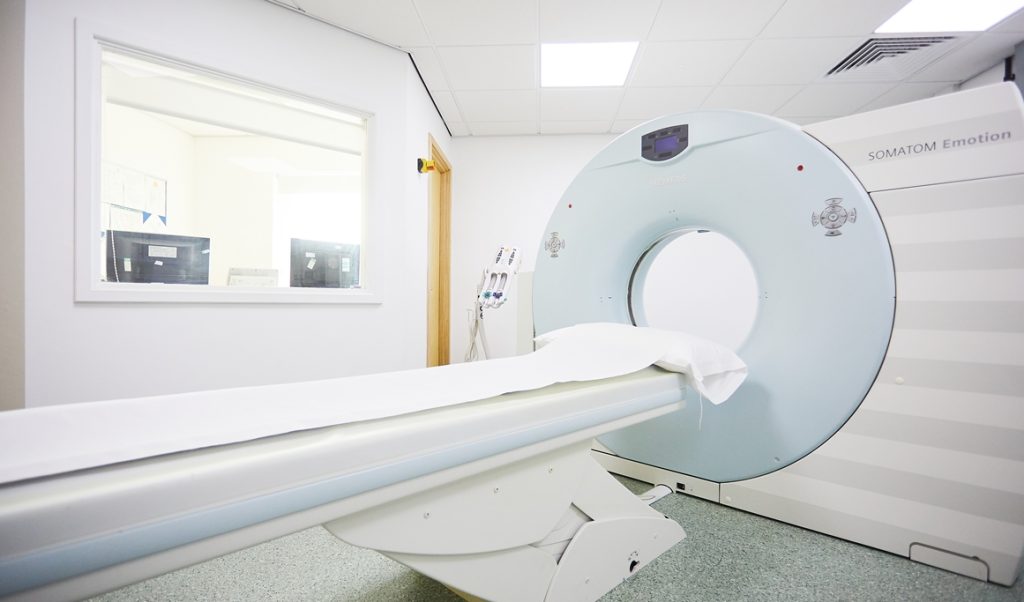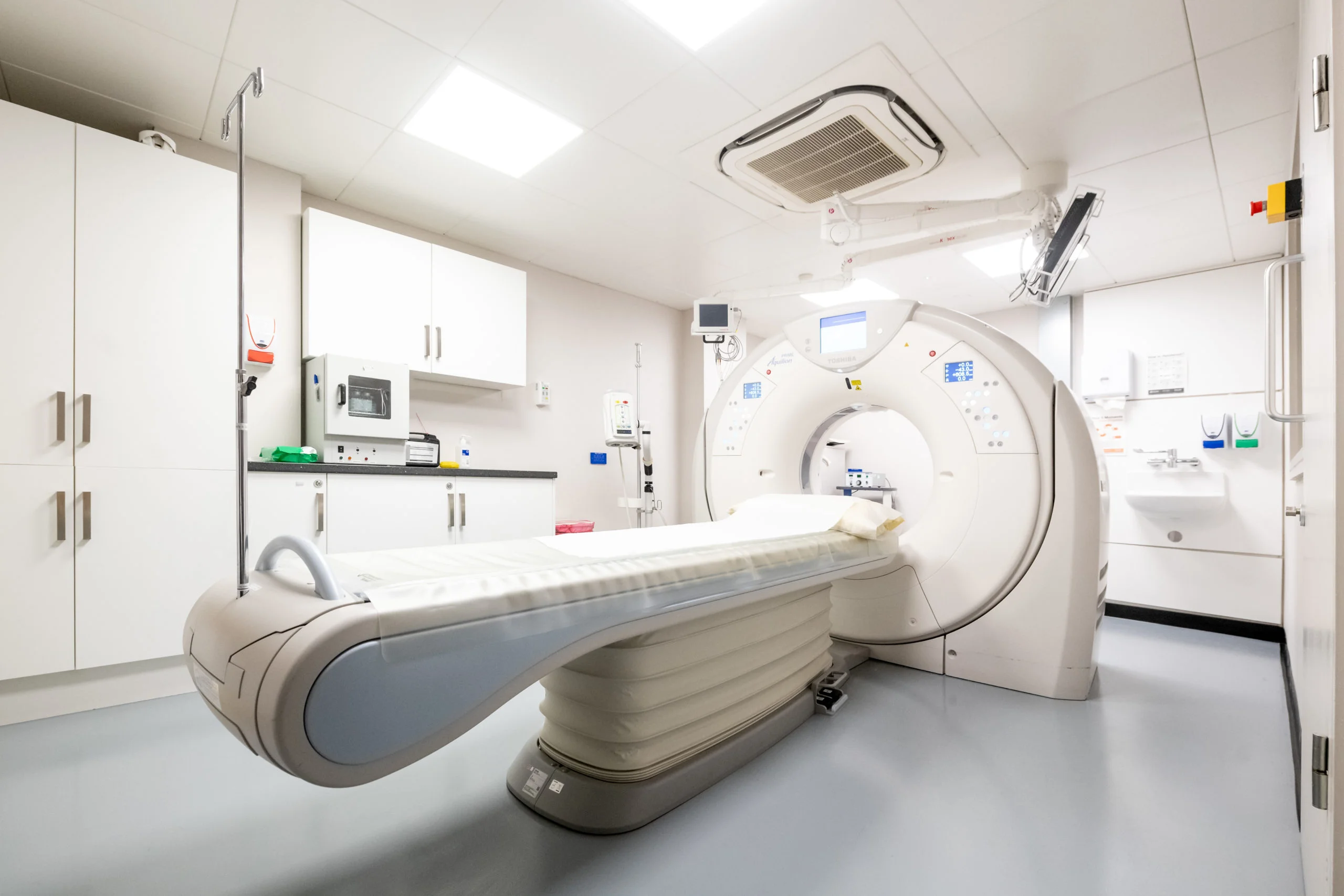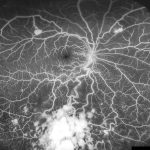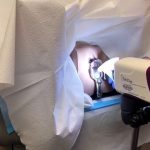CT (computed tomography) colonography is a test that uses CT scans to check the large bowel (colon) and back passage (rectum). It’s also called a virtual colonoscopy.
You have this test as an outpatient in the CT scanning (or radiology) department at the hospital. A radiographer or specialist doctor (radiologist) carries out the test.
It usually takes around 30 minutes but you should expect to be in the department for about an hour or so.
Why do I need a CT colonography?
You usually have this test to help find the cause of your symptoms.
Before your test
You need to have an empty bowel for this test. This is so the radiographer can clearly see the inside of your bowel and rectum.
You’ll get clear written information on what to do before you have a scan. Your preparation usually starts a couple of days before the test.
You need to take strong medication (laxatives) to empty your bowel the day before. Or you might need to drink a special liquid (contrast medium) called gastrografin over 1 or 2 days.
Gastrografin is a type of dye containing iodine. It helps to make scan pictures clearer. It also acts as a laxative and may give you diarrhoea.
Having gastrografin or laxatives will mean that you need to open your bowels often, and very suddenly. You might also have some cramping pains. It’s best to stay at home for a few hours after taking gastrografin or the laxatives, so that you are near a toilet.
You might also need to follow a low fibre diet for 1 or 2 days before the test.
To prevent dehydration it’s important to drink plenty of clear fluids such as:
- water
- black tea or coffee
- squash (without red or purple colouring)
- clear soup
You may need to stop taking iron tablets or other medicines which can cause constipation. You usually stop these one week before the test.
Contact the radiology department as soon as possible before your appointment if you take medicines to thin your blood or you are diabetic. You’ll get other instructions to follow.
What happens
When you arrive you usually fill out a checklist or questionnaire with the radiographer. They will explain the procedure and ask you to sign a consent form. They ask you questions about your medical history and any allergies. It’s a good time to ask them any further questions that you may have.
They’ll ask you to change into a hospital gown.
You might have a medicine to relax your bowel muscles. This medicine is Buscopan. You have it as an injection through a fine tube (cannula) into your bloodstream.
You lie on the couch on your side.
The radiographer puts a small tube a few centimetres long into your rectum. They then pump carbon dioxide or air inside. This opens the bowel, helping to get clear scans of the inside of your bowel. You may feel uncomfortable and bloated. Rarely, people have pain.
Having a CT colonography
A CT colonography is a test to look at the inside of your bowel.
Your bowel needs to be empty for the test so you have to follow a special diet for a couple of days beforehand. Usually a low fibre or liquid diet.
You’ll be given instructions about what you need to do.
Before the test you take a laxative or a special liquid called gastrografin. This is a dye to help make the scan clearer but also works as a laxative.
You will have diarrhoea so it’s best to stay at home close to a toilet.
On the day of the test you can continue to drink clear fluids up to a few hours before.
The radiographer puts a small tube called a cannula into a vein in your arm or the back of your hand.
You may have a drug through this cannula to relax your bowel muscles. This reduces cramping during your test.
You may need to have an injection of x-ray dye through the cannula. This helps to show the other organs outside of the bowel.
You then need to lie on your left side. The radiographer will put a small tube into your back passage to pump air or carbon dioxide inside your bowel.
This helps to open up the bowel to make it easier to see it on the computer.
You may feel as if you need to go the toilet or to pass wind. It is normal but try to keep in as much gas as you can.
You then have 2 or 3 CT scans in different positions. All of your images will be looked at using a special computer programme.
This shows up any growths or abnormal areas on your bowel wall.
After the test you may feel bloated, have stomach pains and pass wind. This doesn’t last long.
To make sure you’re ok you usually stay in the department for 20 minutes. Then you can go home and eat and drink normally again.
You usually get the results within a couple of weeks from the person who sent you for the test.
During the scan
The radiographer will then ask you to lie on your front and the scanning table moves into the CT scanner. The middle part of your body is in the centre of the ring. You will be alone in the room while you have the scan. But they can still see you and talk to you through an intercom.
Midway through your scan you might have an injection of contrast medium  . This helps show up the bowel more clearly on the scans. You have this through your cannula.
. This helps show up the bowel more clearly on the scans. You have this through your cannula.
You often have a second scan lying on your back. At certain times the radiographer may ask you to hold your breath for a few seconds. It is important that you lie as still as you can during the scan.
A computer matches all the scans you’ve had to make a virtual scan of the inside of your bowel.
After your scan
After the scan the radiographer removes the tube from your back passage, and shows you to the toilet. You usually stay in the department for a short time after the test. This is to check you don’t have an allergic reaction to the Buscopan or the contrast medium.
The radiographer will remove the cannula from your vein when its time for you to go home. You can eat, drink and take your medicines as normal after the scan.
Possible risks
CT colonography is a very safe procedure. Your radiographer will tell you who to contact if you have any problems after your test. Your doctor will make sure the benefits of having a CT colonography outweigh the possible risks.
Some of the possible risks include:
Loss of body fluid (dehydration)
Clearing the bowel can cause dehydration in some people. It is very important to drink plenty of fluids before and after your scan.
Effects of gastrografin
Gastrografin can make people feel or be sick. It may cause a mild rash but this is uncommon. Very rarely you can have an allergic reaction. If you feel ill or have problems breathing during the test, tell the radiographer straight away.
Effects of contrast medium
The injection of contrast medium might make you hot and flushed for a few minutes. You might get a metallic taste in your mouth. It is common to feel warmth like you are passing urine, but you are not. This feeling goes away quickly.
Very rarely, people have a reaction to the contrast medium. If you feel ill or have problems breathing during the test, tell the radiographer straight away.
Tummy (abdominal) pain
You may have some bloating or pain in your abdomen after the test. This is due to the carbon dioxide or air put into the bowel. This should go away shortly afterwards.
Tear in your bowel
There is a small risk of a tear (perforation) in your bowel. This is very rare. If it happened you would often need surgery to repair the tear.
Blurred vision
The medicine used to relax your bowel wall might cause temporary blurred vision. You shouldn’t drive for an hour or so or until your vision has returned to normal. Tell your radiographer if you have glaucoma or heart problems before you have medicine to relax your bowels.
Radiation exposure
CT scanners use x-rays to make images which use a small amount of radiation. Exposure to radiation during a CT scan can slightly increase your risk of developing cancer in the future. Talk to your doctor if this worries you.
You should not have CT colonography if there is a risk that you are pregnant.
Getting your results
It can take up to 1 to 2 weeks to get your results. You usually get your results from your specialist. It is important to check with your doctor how long you should expect to wait for your results.
Waiting for results can be an anxious time. It might be helpful to talk to someone close to you.
If you have not had your results a few weeks after your test, you could contact your doctor to chase your results for you.





